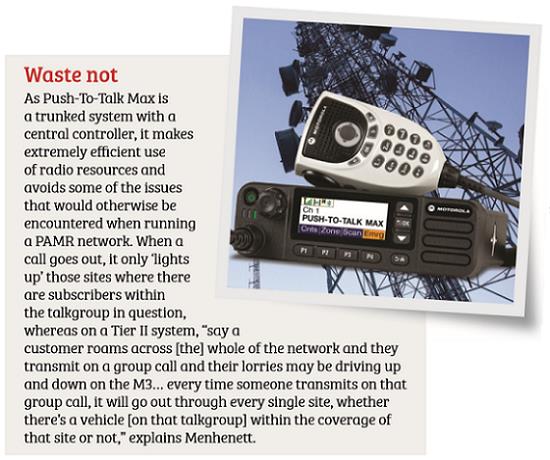“[We started] probably about six or seven years ago,” says Stewart Menhenett, director at Push-To-Talk Systems, “and [as] there were no dealers offering a wide-area digital solution within the M25, we started to build this up and found a lot of people were using public access mobile radio (PAMR), Band III sort of systems that weren’t working very well. So, we demonstrated what MOTOTRBO could do and took quite a lot of business off some of these old systems, and started to increase the coverage.
“[However], at one point I couldn’t understand why we weren’t getting [a huge amount of] work, and [it was because many people require more] coverage than just [within the] M25, so when we started to expand down to Southampton and out into Essex, we started to pick [up more] work. And it developed from there, with more sites and more customers… to the point that we [migrated] to [DMR Tier III]/Capacity Max last year [from DMR Tier II/ Linked Capacity Plus], which was a massive step for the business.”
The big bang
So how did Push-To-Talk Systems go about making this transition? Menhenett says while it quickly realised there would have to be “one big bang”, some sites surrounding London could be migrated in a slightly slower manner. The bulk of the migration occurred during a weekend. “[We had] from about 4pm on Friday afternoon [to] 6am Monday morning to do the whole transition and make it work,” he adds. “I never want to live through that again!” While about 15-16 sites had to be migrated, Menhenett explains that the biggest challenge was caused by the logistics of upgrading the firmware on so many mobile terminals – around 900 sets – out in the field in about 35 locations, and this could only be done out of hours. While this took several months to do, about 700 sets had to be reprogrammed over the weekend of the transition by Push-To-Talk Systems’ roughly 10-strong project team. This process required them to load radios into the Capacity Max system’s Radio Management software on Push-To-Talk Systems’ server, and it required an IP connection back to the server to program the radios. “So it wasn’t like you bring a handportable in, you plug your laptop into your Ethernet and off you go; you’re in the middle of lorry yards where you don’t have any of those luxuries, so we were relying on 4G and 3G to do the handshake and make it work – we did it, but it was quite a challenge,” Menhenett says.
Fortunately, help was on hand from RadioTrade, the supplier of the MOTOTRBO Capacity Max equipment, as Peter Bearryman, RadioTrade’s director of sales and marketing, explains. “We pride ourselves on having the technical expertise to support customers like Push-To-Talk who supply or operate more complex networks. Push-To-Talk have been a long-standing customer of RadioTrade as they were developing their system. As a Motorola Solutions Value Added Distributor, we keep all the various Motorola Solutions technologies in operation at our facility, including a Capacity Max system for customer support, testing and demonstrations, and we use this as a testbed for upgrades to Stewart’s network. He asked us for support with the upgrade from Capacity Plus to Capacity Max, and our expert technical team provided it. They were standing by throughout the weekend of the migration, pretty much night and day, to remotely monitor and configure the system, answer any questions and help with any issues that arose. We also provide ongoing support to Push-To-Talk with upgrades and expansion of the network and serve as their interface to Motorola Solutions.”
“RadioTrade have supported this right from the beginning, and without the support they give, we wouldn’t be where we are today,” adds Push-To-Talk Systems’ Menhenett. “So, I recommend that anyone that is looking to build a DMR Tier III system look to RadioTrade for their expertise and support.”
One choice that Menhenett says has helped Push-To-Talk Max avoid the fate of some other PAMR systems was the decision to use VHF, “so the number of sites we need to cover quite a large area is relatively small, whereas if you go up in frequency band to UHF, it’s more of a cellular model, where you would need a lot more sites, and the cost of running that goes up [and] the number of users you need to make that viable goes up.”
Aside from migrating to Capacity Max, the other big challenge that Push-To-Talk Systems had to address when scaling up its systems was finding the right sites in the right locations to provide the required coverage, and the expense of getting onto these. In addition, “particularly in London and the South East, it is very hard to get hold of exclusive spectrum – on UHF, it’s more or less impossible, on VHF it’s very difficult, but we’ve secured a lot of exclusive spectrum on some very high hill-top sites [and] that’s helped. It’s been a case of everything just coming together: the support from RadioTrade, Motorola Solutions bringing a product out that fitted all of our current and future requirements, getting the correct spectrum from Ofcom, and finding suitable radio sites to provide the wide radio coverage. We’ve changed how we [handle] sites, because when we first started we used to use very small guyed masts on farms and now we’ve got contracts with major UK telecoms providers,” Menhenett says.

Modern day management
Turning to day-to-day running of the network, this is handled via a combination of TRBOnet Watch and System Advisor software – the latter is unique to Capacity Max – and these allow Push-To-Talk Systems to detect and resolve many issues before they would be noticed by its users. “System Advisor is designed to monitor all of the components on the system,” says Menhenett. “If you get any sort of failure, it will display an alarm and it will log it. It [also] gives us the ability to monitor each radio site and see what calls are going through there on a slot-by-slot basis; it will display if the system queues a call, [and] that’s a feature that isn’t available on any of the lower-tier Motorola products – Capacity Max supports call queuing for calls if any of the infrastructure is busy.”
He adds that transmit interrupt is used on the base stations, which prevents “anyone from hogging a channel or a talkgroup”, and all the radios are fitted with timeout timers to address things like a microphone getting wedged under a seat with the PTT button depressed, and the company can remotely turn terminals on or off if they need to. The system also supports over-the-air programming (OTAP) and has 10 levels of prioritisation.
“We use OTAP to reprogram all the radios remotely,” says Menhenett, “and that’s a massive thing for us as a company; in days gone past, I’d have to wait for a batch of lorries to come in at the end of the day and jump in with a laptop. Now, I can do it from my laptop wherever I’ve got a broadband connection, it’s all scheduled with Radio Manager, [which is] designed to batch program stuff [instead of the traditional] one-by-one [approach], and it’s incredibly versatile in what it can do.”
He explains that as Capacity Max networks require terminals to register with their servers and have a function called ‘presence notifier’, OTAP is handled in a way that puts minimum strain on network resources. “When a radio is turned on and there is a job sitting on the server ready to reprogram that radio, the presence notifier within the system will say ‘oh, I recognise the ID of that radio, I know I’ve got a programming job for that, I’m going to reprogram it.’ If you didn’t have presence notifier, [the system] would carry on polling that radio all the time until it comes on.”
Menhenett notes that this degree of flexibility is often highlighted as one of PTT over Cellular (PoC)’s strengths – “People say: ‘PoC’s great because you can program things remotely’, but we can do the same with this [and it’s] all DMR.”
While we’re discussing PoC, Menhenett says he and his team experiment with it “because it’s potentially our competition. When it’s running 4G to 4G it’s not too bad, but the minute one side of it falls back to 3G, you’ll wait five seconds for someone to reply.” He adds that typically 3G will run at around a latency of 300-400ms over the network backbone whereas “the latency across our network backbone from site to site is about 30ms”. Finally, unlike a PoC system, there are no separate data costs for making or sending calls with Push-To-Talk Max. “You pay [for your] monthly airtime and you can use it as little or as much as you want and we don’t clamp it down,” he adds.

Bringing them onboard
So what’s Push-To-Talk Systems’ current focus? “[It’s now] all about getting dealers involved, showing them there is a DMR solution for providing wide-area [coverage] to their customers, [especially those] that operate in areas where cellular coverage is poor,” says Menhenett, “[and] because of how Capacity Max works, it’s very easy to add sites.” He adds that Linked Capacity Plus is limited to 15 sites, while Capacity Max can support 250. “So, if someone came to us tomorrow and said ‘we like your system, we want to put a thousand radios on it, can you give us coverage up to Birmingham?’, we can work all of that out, and from an infrastructure point of view it’s just a matter of ordering kit, loading racks up and doing it – it’s very straightforward because the technology now supports it.”
He highlights that part of Push-To-Talk Max’s appeal lies in the effort and expense that other two-way radio dealers would otherwise have to go to if they or one of their customers required a DMR solution and couldn’t rely on cellular coverage, given that “getting channels is slow, it’s very difficult in certain parts of London, the South East; secondly, getting agreements with all the providers we have for the towers and getting things rigged is incredibly expensive, so it’s not something that someone could turn around [and deliver in] three months, you’re probably talking a number of years to roll out even a five- or six-site [network, whereas our system] within the areas where we have fixed infrastructure is off the shelf, we’ve got capacity and we’ve got coverage.”
It’s worth noting that non-Motorola mobile terminals could be made to work on Push-To-Talk Max, though the users wouldn’t reap the benefits from the proprietary features that Motorola has added on top of the DMR standard. There is also the fact that while the system has been engineered specifically to provide reliable coverage for mobile terminals, “it’s suitable for people that have customers in rural areas where the cellular coverage is poor to try it to see if it meets their requirements [for handheld terminal use]”. The consistent mobile coverage has been achieved partly through the use of overlapping sites, which gets around the tendency of digital terminals to “play ping-pong” on edges of coverage, and the decision to use VHF rather than UHF, which reduces the number of sites required.
It’s great to see reports of the death of wide area radio have been exaggerated and two-way radio dealers have something new to offer hauliers, bus companies, gritter lorries and local authorities. It’s also encouraging to hear from Menhenett that, as he is aware of the grandiose claim made by previous wide-area offerings, he is focusing on getting dealers to try it themselves. At Land Mobile, we’ll be following Push-To-Talk Systems’ future with interest.



